Evaluating Performance: Human Resource Strategies for Individuals
VerifiedAdded on 2023/06/09
|13
|3387
|489
Report
AI Summary
This report delves into the realm of Human Resource Management (HRM) practices and their profound impact on individual employee performance, ultimately contributing to the overall success and competitive advantage of an organization. It explores various theoretical HRM factors and strategic models, with a particular focus on the AMO (ability, motivation, opportunity) model, which considers these three elements as key determinants of individual performance. The report analyzes the universalistic, contingency, and configurational theories, highlighting their applications and limitations in enhancing employee motivation, skills, and autonomy. Furthermore, it addresses the challenges faced during the implementation of HR strategies, including issues related to productivity, empowerment, burnouts, job insecurity, ethics, and social responsibility, emphasizing the interconnectedness of these factors and their influence on organizational culture. The paper concludes by underscoring the importance of collaboration between HRM, Operations Management, and the Board of Directors in developing and implementing sustainable policies that foster employee engagement and drive performance improvements.
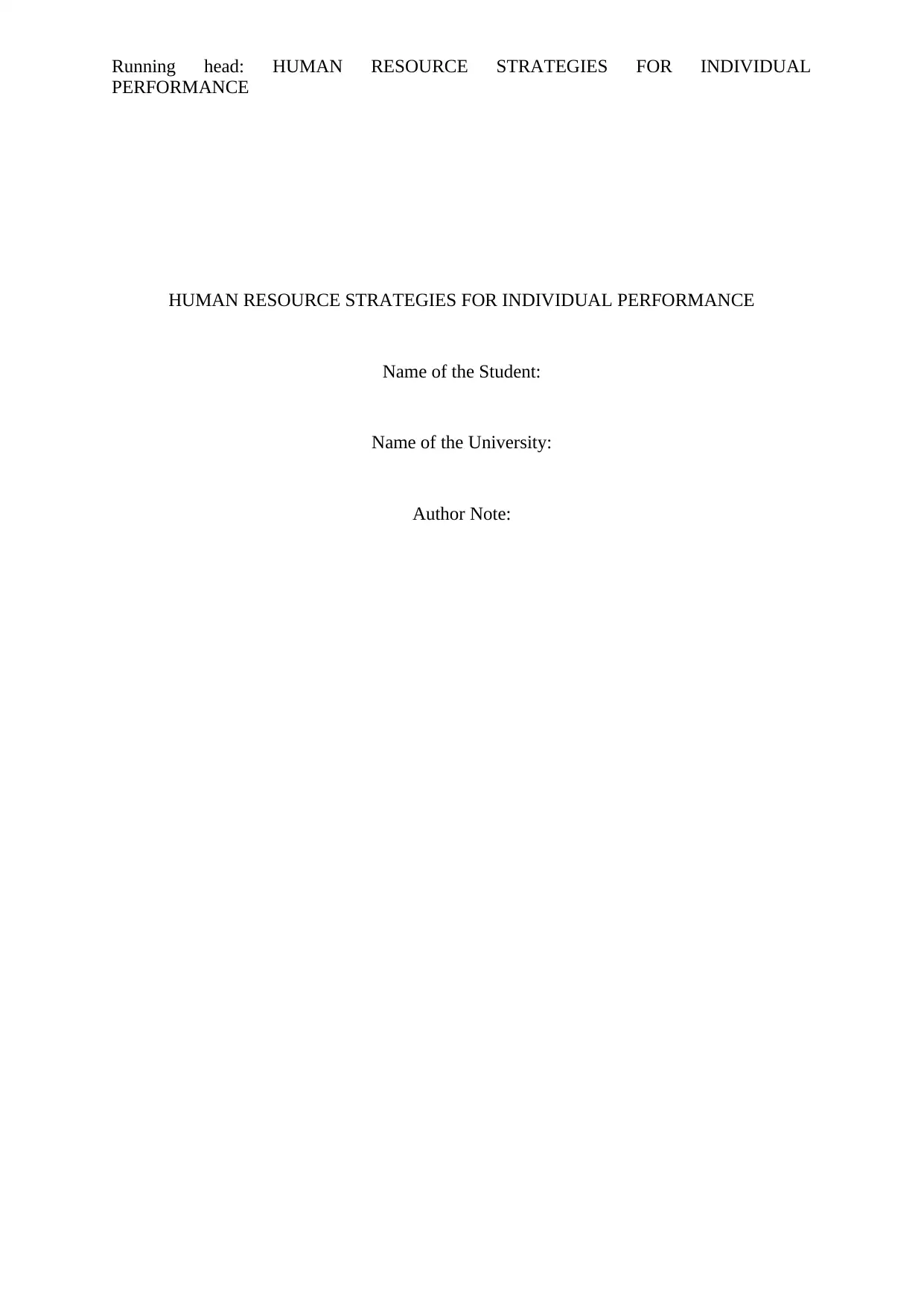
Running head: HUMAN RESOURCE STRATEGIES FOR INDIVIDUAL
PERFORMANCE
HUMAN RESOURCE STRATEGIES FOR INDIVIDUAL PERFORMANCE
Name of the Student:
Name of the University:
Author Note:
PERFORMANCE
HUMAN RESOURCE STRATEGIES FOR INDIVIDUAL PERFORMANCE
Name of the Student:
Name of the University:
Author Note:
Paraphrase This Document
Need a fresh take? Get an instant paraphrase of this document with our AI Paraphraser
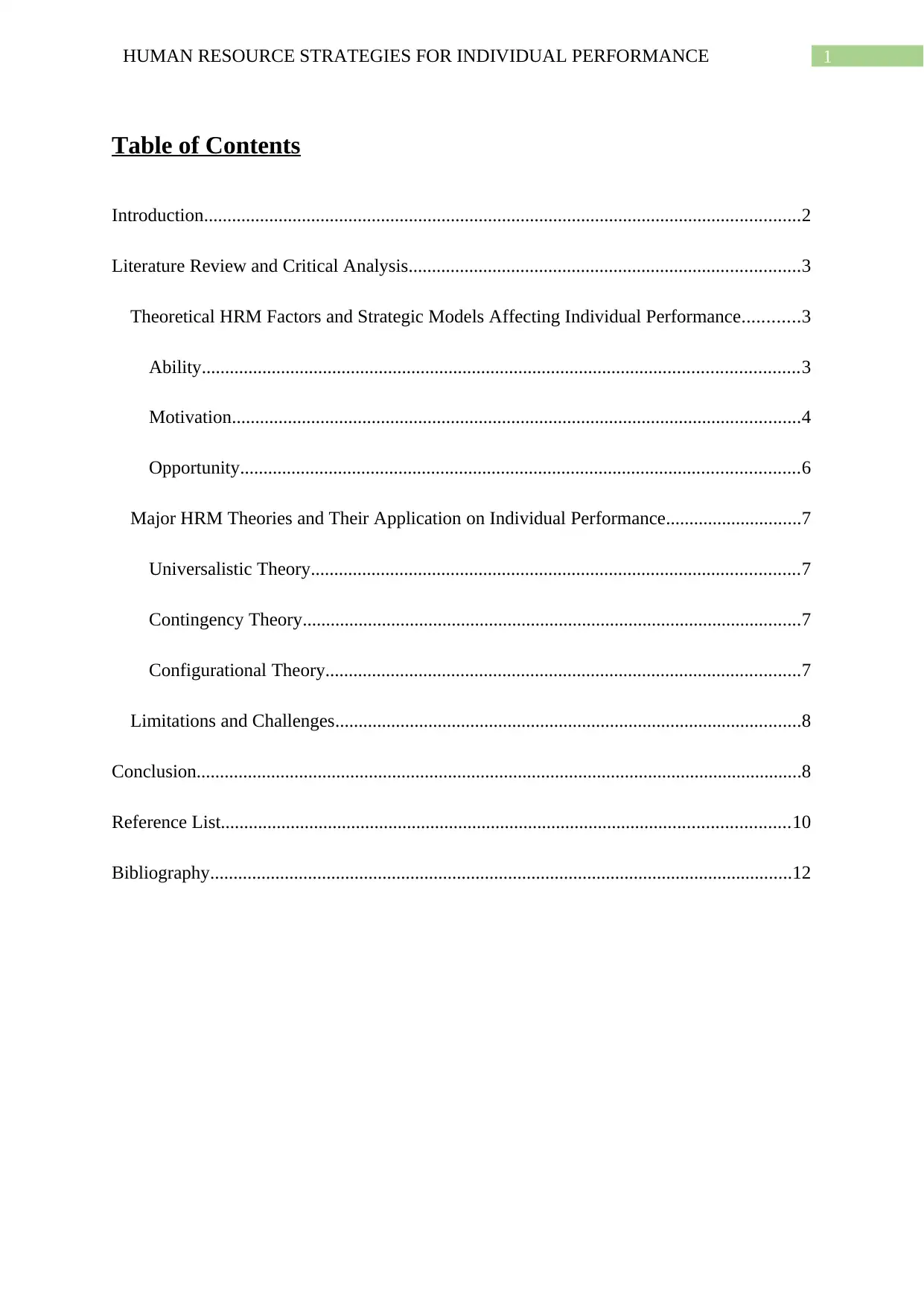
1HUMAN RESOURCE STRATEGIES FOR INDIVIDUAL PERFORMANCE
Table of Contents
Introduction................................................................................................................................2
Literature Review and Critical Analysis....................................................................................3
Theoretical HRM Factors and Strategic Models Affecting Individual Performance............3
Ability................................................................................................................................3
Motivation..........................................................................................................................4
Opportunity........................................................................................................................6
Major HRM Theories and Their Application on Individual Performance.............................7
Universalistic Theory.........................................................................................................7
Contingency Theory...........................................................................................................7
Configurational Theory......................................................................................................7
Limitations and Challenges....................................................................................................8
Conclusion..................................................................................................................................8
Reference List..........................................................................................................................10
Bibliography.............................................................................................................................12
Table of Contents
Introduction................................................................................................................................2
Literature Review and Critical Analysis....................................................................................3
Theoretical HRM Factors and Strategic Models Affecting Individual Performance............3
Ability................................................................................................................................3
Motivation..........................................................................................................................4
Opportunity........................................................................................................................6
Major HRM Theories and Their Application on Individual Performance.............................7
Universalistic Theory.........................................................................................................7
Contingency Theory...........................................................................................................7
Configurational Theory......................................................................................................7
Limitations and Challenges....................................................................................................8
Conclusion..................................................................................................................................8
Reference List..........................................................................................................................10
Bibliography.............................................................................................................................12
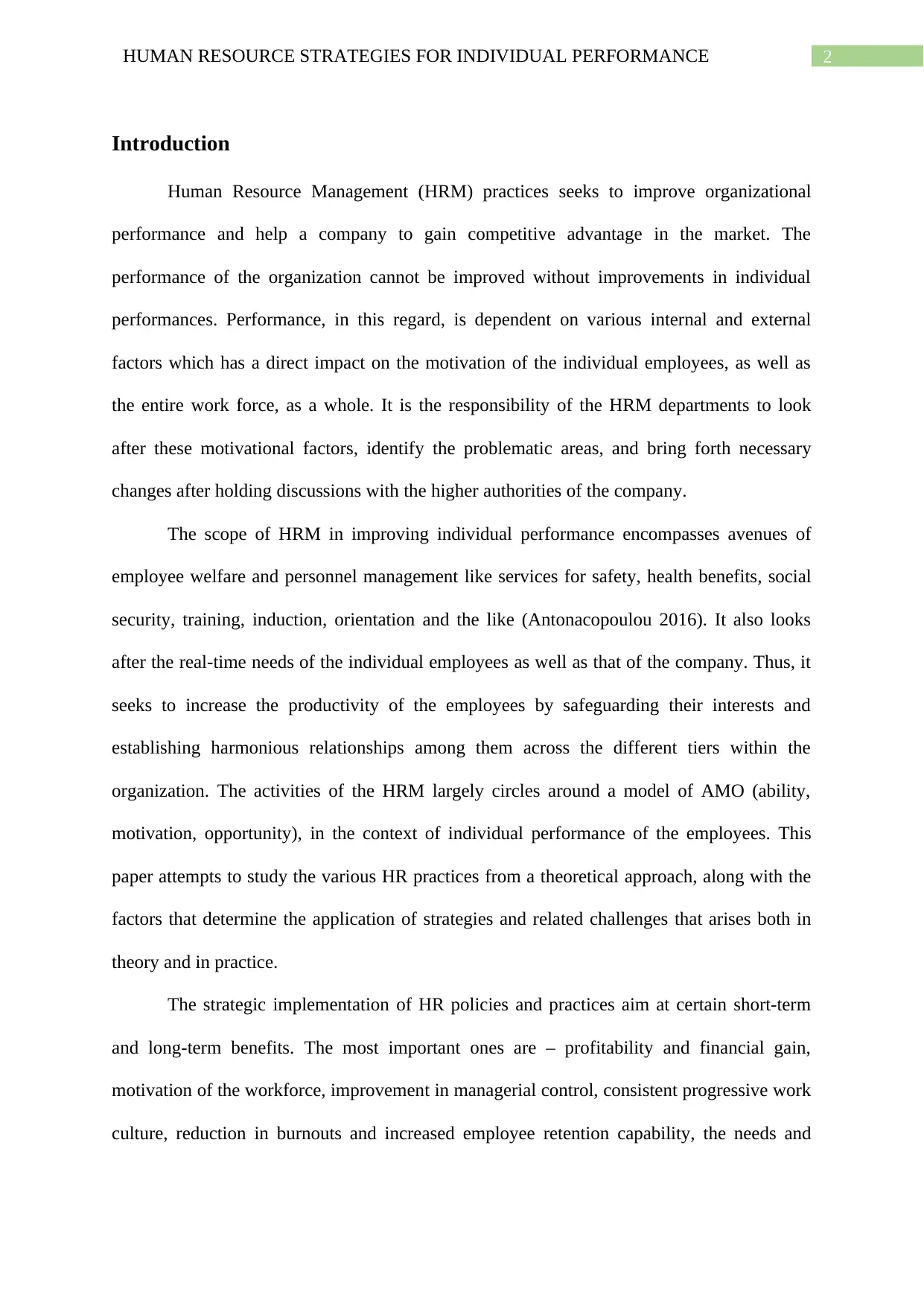
2HUMAN RESOURCE STRATEGIES FOR INDIVIDUAL PERFORMANCE
Introduction
Human Resource Management (HRM) practices seeks to improve organizational
performance and help a company to gain competitive advantage in the market. The
performance of the organization cannot be improved without improvements in individual
performances. Performance, in this regard, is dependent on various internal and external
factors which has a direct impact on the motivation of the individual employees, as well as
the entire work force, as a whole. It is the responsibility of the HRM departments to look
after these motivational factors, identify the problematic areas, and bring forth necessary
changes after holding discussions with the higher authorities of the company.
The scope of HRM in improving individual performance encompasses avenues of
employee welfare and personnel management like services for safety, health benefits, social
security, training, induction, orientation and the like (Antonacopoulou 2016). It also looks
after the real-time needs of the individual employees as well as that of the company. Thus, it
seeks to increase the productivity of the employees by safeguarding their interests and
establishing harmonious relationships among them across the different tiers within the
organization. The activities of the HRM largely circles around a model of AMO (ability,
motivation, opportunity), in the context of individual performance of the employees. This
paper attempts to study the various HR practices from a theoretical approach, along with the
factors that determine the application of strategies and related challenges that arises both in
theory and in practice.
The strategic implementation of HR policies and practices aim at certain short-term
and long-term benefits. The most important ones are – profitability and financial gain,
motivation of the workforce, improvement in managerial control, consistent progressive work
culture, reduction in burnouts and increased employee retention capability, the needs and
Introduction
Human Resource Management (HRM) practices seeks to improve organizational
performance and help a company to gain competitive advantage in the market. The
performance of the organization cannot be improved without improvements in individual
performances. Performance, in this regard, is dependent on various internal and external
factors which has a direct impact on the motivation of the individual employees, as well as
the entire work force, as a whole. It is the responsibility of the HRM departments to look
after these motivational factors, identify the problematic areas, and bring forth necessary
changes after holding discussions with the higher authorities of the company.
The scope of HRM in improving individual performance encompasses avenues of
employee welfare and personnel management like services for safety, health benefits, social
security, training, induction, orientation and the like (Antonacopoulou 2016). It also looks
after the real-time needs of the individual employees as well as that of the company. Thus, it
seeks to increase the productivity of the employees by safeguarding their interests and
establishing harmonious relationships among them across the different tiers within the
organization. The activities of the HRM largely circles around a model of AMO (ability,
motivation, opportunity), in the context of individual performance of the employees. This
paper attempts to study the various HR practices from a theoretical approach, along with the
factors that determine the application of strategies and related challenges that arises both in
theory and in practice.
The strategic implementation of HR policies and practices aim at certain short-term
and long-term benefits. The most important ones are – profitability and financial gain,
motivation of the workforce, improvement in managerial control, consistent progressive work
culture, reduction in burnouts and increased employee retention capability, the needs and
⊘ This is a preview!⊘
Do you want full access?
Subscribe today to unlock all pages.

Trusted by 1+ million students worldwide
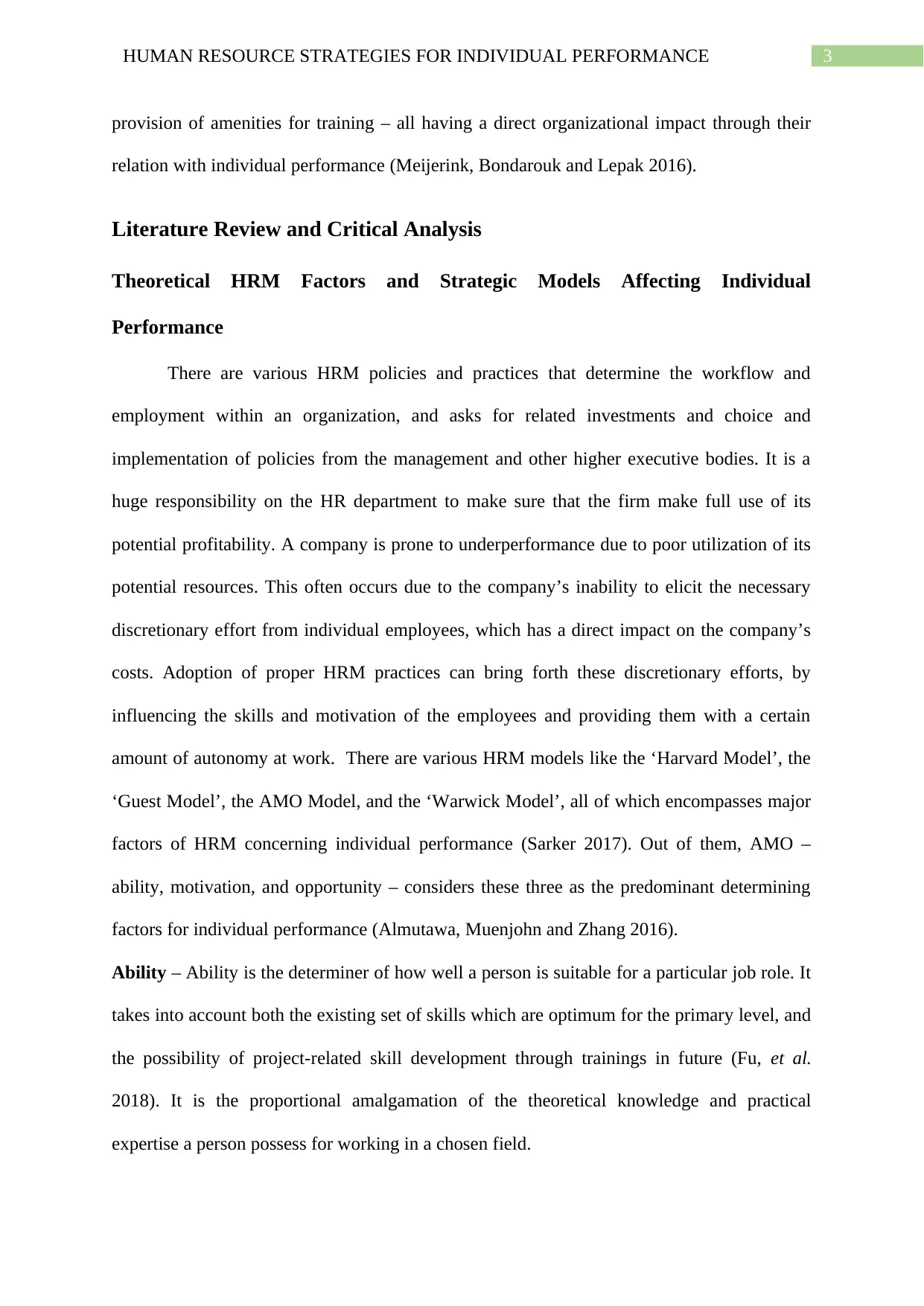
3HUMAN RESOURCE STRATEGIES FOR INDIVIDUAL PERFORMANCE
provision of amenities for training – all having a direct organizational impact through their
relation with individual performance (Meijerink, Bondarouk and Lepak 2016).
Literature Review and Critical Analysis
Theoretical HRM Factors and Strategic Models Affecting Individual
Performance
There are various HRM policies and practices that determine the workflow and
employment within an organization, and asks for related investments and choice and
implementation of policies from the management and other higher executive bodies. It is a
huge responsibility on the HR department to make sure that the firm make full use of its
potential profitability. A company is prone to underperformance due to poor utilization of its
potential resources. This often occurs due to the company’s inability to elicit the necessary
discretionary effort from individual employees, which has a direct impact on the company’s
costs. Adoption of proper HRM practices can bring forth these discretionary efforts, by
influencing the skills and motivation of the employees and providing them with a certain
amount of autonomy at work. There are various HRM models like the ‘Harvard Model’, the
‘Guest Model’, the AMO Model, and the ‘Warwick Model’, all of which encompasses major
factors of HRM concerning individual performance (Sarker 2017). Out of them, AMO –
ability, motivation, and opportunity – considers these three as the predominant determining
factors for individual performance (Almutawa, Muenjohn and Zhang 2016).
Ability – Ability is the determiner of how well a person is suitable for a particular job role. It
takes into account both the existing set of skills which are optimum for the primary level, and
the possibility of project-related skill development through trainings in future (Fu, et al.
2018). It is the proportional amalgamation of the theoretical knowledge and practical
expertise a person possess for working in a chosen field.
provision of amenities for training – all having a direct organizational impact through their
relation with individual performance (Meijerink, Bondarouk and Lepak 2016).
Literature Review and Critical Analysis
Theoretical HRM Factors and Strategic Models Affecting Individual
Performance
There are various HRM policies and practices that determine the workflow and
employment within an organization, and asks for related investments and choice and
implementation of policies from the management and other higher executive bodies. It is a
huge responsibility on the HR department to make sure that the firm make full use of its
potential profitability. A company is prone to underperformance due to poor utilization of its
potential resources. This often occurs due to the company’s inability to elicit the necessary
discretionary effort from individual employees, which has a direct impact on the company’s
costs. Adoption of proper HRM practices can bring forth these discretionary efforts, by
influencing the skills and motivation of the employees and providing them with a certain
amount of autonomy at work. There are various HRM models like the ‘Harvard Model’, the
‘Guest Model’, the AMO Model, and the ‘Warwick Model’, all of which encompasses major
factors of HRM concerning individual performance (Sarker 2017). Out of them, AMO –
ability, motivation, and opportunity – considers these three as the predominant determining
factors for individual performance (Almutawa, Muenjohn and Zhang 2016).
Ability – Ability is the determiner of how well a person is suitable for a particular job role. It
takes into account both the existing set of skills which are optimum for the primary level, and
the possibility of project-related skill development through trainings in future (Fu, et al.
2018). It is the proportional amalgamation of the theoretical knowledge and practical
expertise a person possess for working in a chosen field.
Paraphrase This Document
Need a fresh take? Get an instant paraphrase of this document with our AI Paraphraser
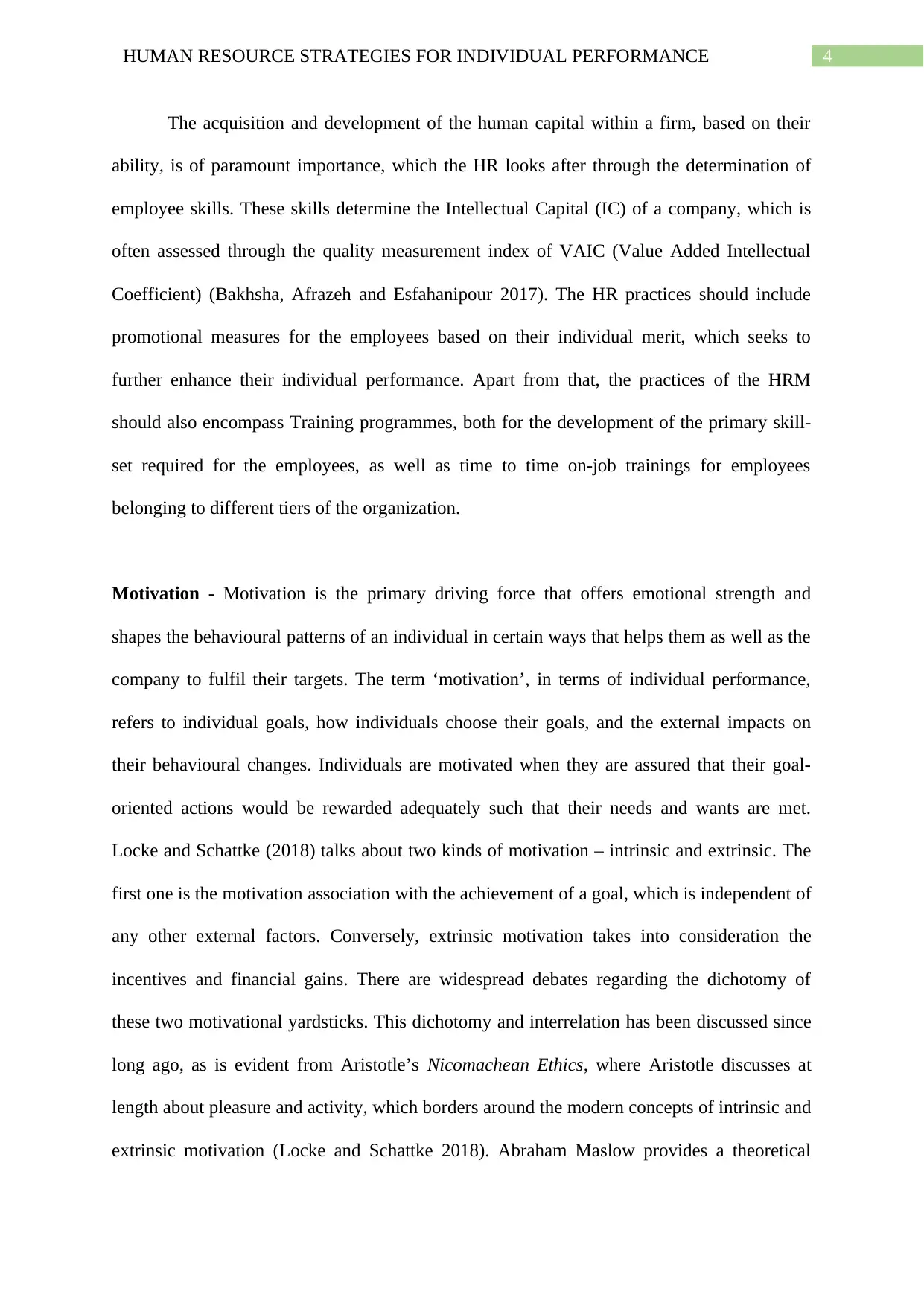
4HUMAN RESOURCE STRATEGIES FOR INDIVIDUAL PERFORMANCE
The acquisition and development of the human capital within a firm, based on their
ability, is of paramount importance, which the HR looks after through the determination of
employee skills. These skills determine the Intellectual Capital (IC) of a company, which is
often assessed through the quality measurement index of VAIC (Value Added Intellectual
Coefficient) (Bakhsha, Afrazeh and Esfahanipour 2017). The HR practices should include
promotional measures for the employees based on their individual merit, which seeks to
further enhance their individual performance. Apart from that, the practices of the HRM
should also encompass Training programmes, both for the development of the primary skill-
set required for the employees, as well as time to time on-job trainings for employees
belonging to different tiers of the organization.
Motivation - Motivation is the primary driving force that offers emotional strength and
shapes the behavioural patterns of an individual in certain ways that helps them as well as the
company to fulfil their targets. The term ‘motivation’, in terms of individual performance,
refers to individual goals, how individuals choose their goals, and the external impacts on
their behavioural changes. Individuals are motivated when they are assured that their goal-
oriented actions would be rewarded adequately such that their needs and wants are met.
Locke and Schattke (2018) talks about two kinds of motivation – intrinsic and extrinsic. The
first one is the motivation association with the achievement of a goal, which is independent of
any other external factors. Conversely, extrinsic motivation takes into consideration the
incentives and financial gains. There are widespread debates regarding the dichotomy of
these two motivational yardsticks. This dichotomy and interrelation has been discussed since
long ago, as is evident from Aristotle’s Nicomachean Ethics, where Aristotle discusses at
length about pleasure and activity, which borders around the modern concepts of intrinsic and
extrinsic motivation (Locke and Schattke 2018). Abraham Maslow provides a theoretical
The acquisition and development of the human capital within a firm, based on their
ability, is of paramount importance, which the HR looks after through the determination of
employee skills. These skills determine the Intellectual Capital (IC) of a company, which is
often assessed through the quality measurement index of VAIC (Value Added Intellectual
Coefficient) (Bakhsha, Afrazeh and Esfahanipour 2017). The HR practices should include
promotional measures for the employees based on their individual merit, which seeks to
further enhance their individual performance. Apart from that, the practices of the HRM
should also encompass Training programmes, both for the development of the primary skill-
set required for the employees, as well as time to time on-job trainings for employees
belonging to different tiers of the organization.
Motivation - Motivation is the primary driving force that offers emotional strength and
shapes the behavioural patterns of an individual in certain ways that helps them as well as the
company to fulfil their targets. The term ‘motivation’, in terms of individual performance,
refers to individual goals, how individuals choose their goals, and the external impacts on
their behavioural changes. Individuals are motivated when they are assured that their goal-
oriented actions would be rewarded adequately such that their needs and wants are met.
Locke and Schattke (2018) talks about two kinds of motivation – intrinsic and extrinsic. The
first one is the motivation association with the achievement of a goal, which is independent of
any other external factors. Conversely, extrinsic motivation takes into consideration the
incentives and financial gains. There are widespread debates regarding the dichotomy of
these two motivational yardsticks. This dichotomy and interrelation has been discussed since
long ago, as is evident from Aristotle’s Nicomachean Ethics, where Aristotle discusses at
length about pleasure and activity, which borders around the modern concepts of intrinsic and
extrinsic motivation (Locke and Schattke 2018). Abraham Maslow provides a theoretical
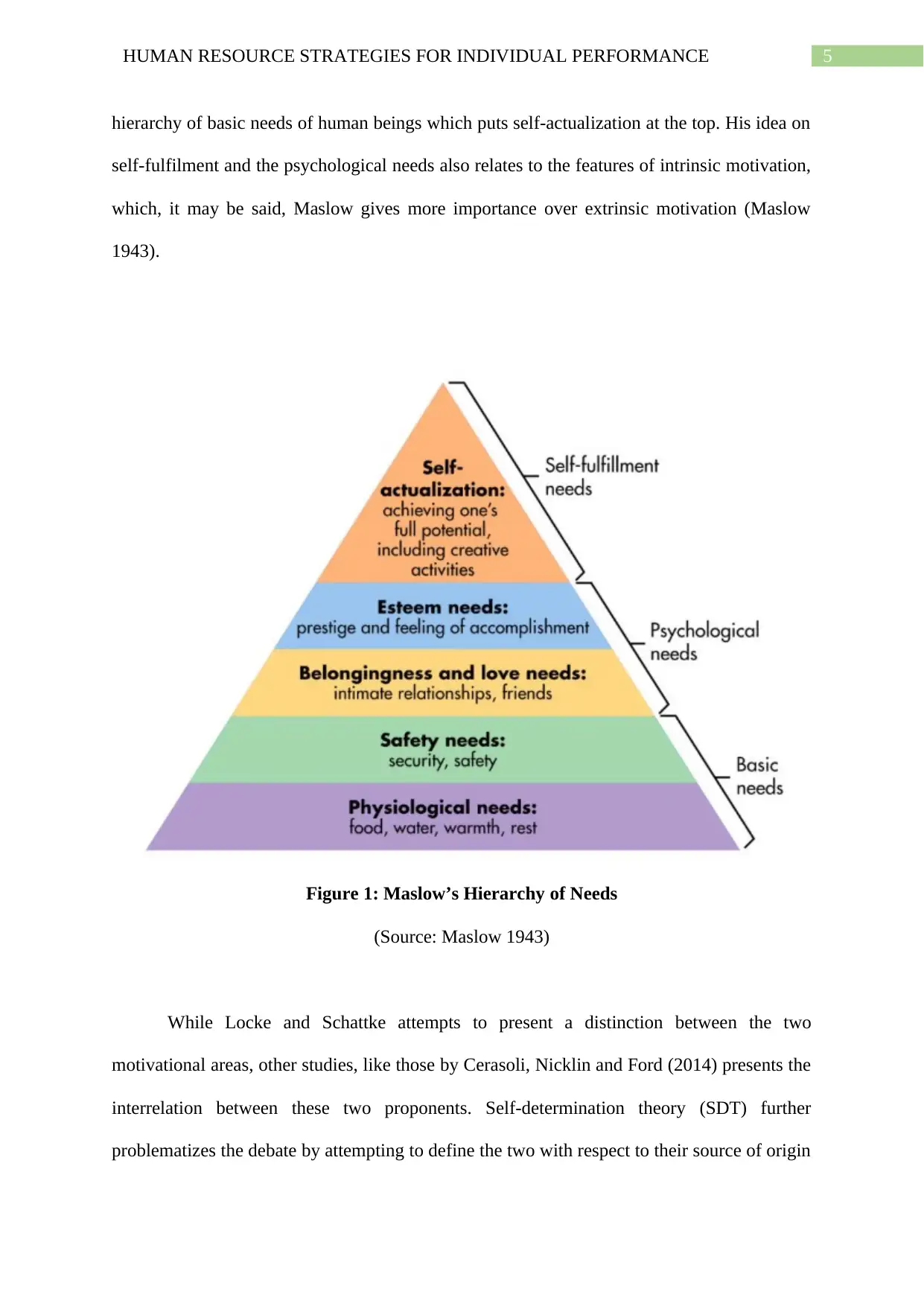
5HUMAN RESOURCE STRATEGIES FOR INDIVIDUAL PERFORMANCE
hierarchy of basic needs of human beings which puts self-actualization at the top. His idea on
self-fulfilment and the psychological needs also relates to the features of intrinsic motivation,
which, it may be said, Maslow gives more importance over extrinsic motivation (Maslow
1943).
Figure 1: Maslow’s Hierarchy of Needs
(Source: Maslow 1943)
While Locke and Schattke attempts to present a distinction between the two
motivational areas, other studies, like those by Cerasoli, Nicklin and Ford (2014) presents the
interrelation between these two proponents. Self-determination theory (SDT) further
problematizes the debate by attempting to define the two with respect to their source of origin
hierarchy of basic needs of human beings which puts self-actualization at the top. His idea on
self-fulfilment and the psychological needs also relates to the features of intrinsic motivation,
which, it may be said, Maslow gives more importance over extrinsic motivation (Maslow
1943).
Figure 1: Maslow’s Hierarchy of Needs
(Source: Maslow 1943)
While Locke and Schattke attempts to present a distinction between the two
motivational areas, other studies, like those by Cerasoli, Nicklin and Ford (2014) presents the
interrelation between these two proponents. Self-determination theory (SDT) further
problematizes the debate by attempting to define the two with respect to their source of origin
⊘ This is a preview!⊘
Do you want full access?
Subscribe today to unlock all pages.

Trusted by 1+ million students worldwide
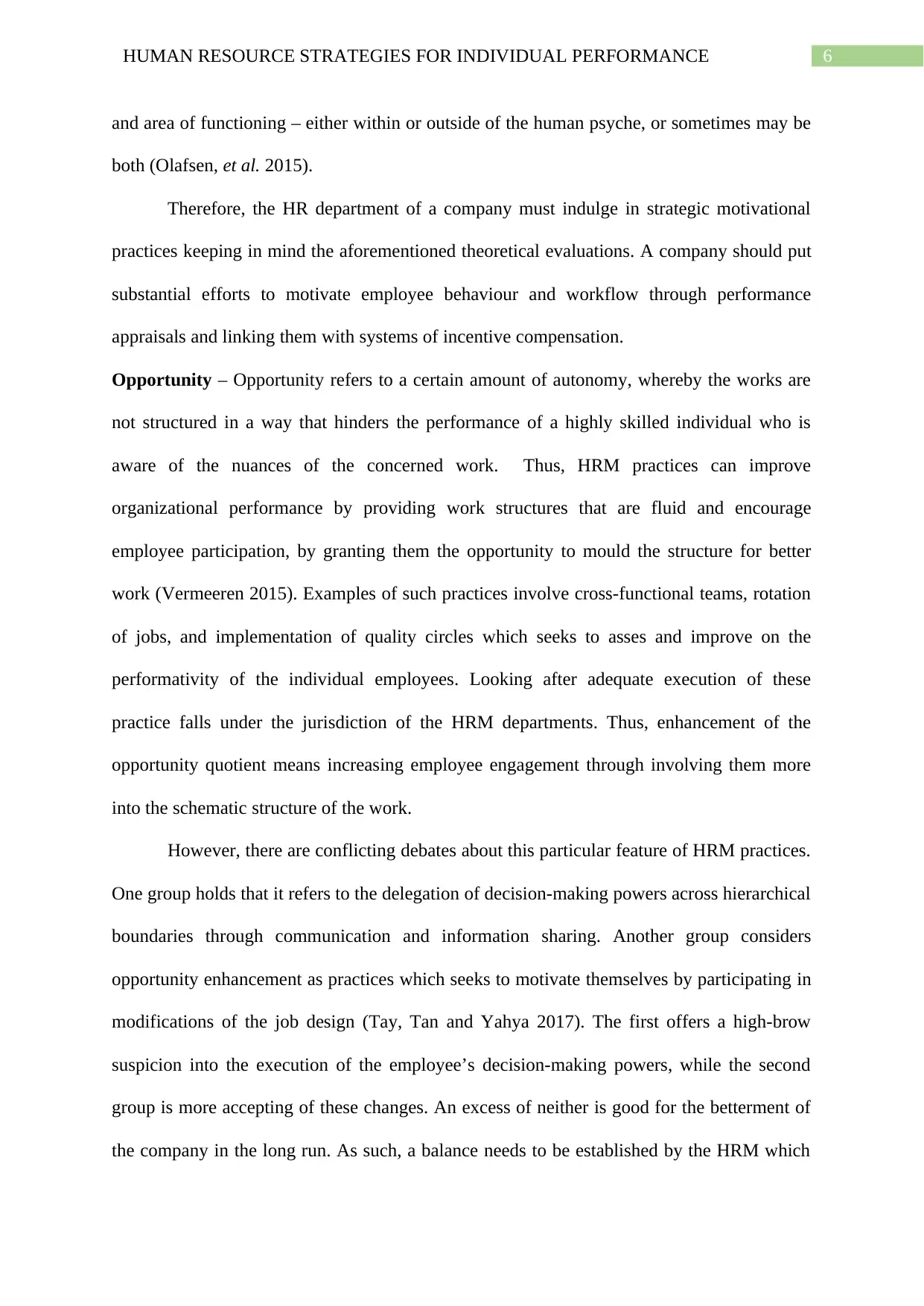
6HUMAN RESOURCE STRATEGIES FOR INDIVIDUAL PERFORMANCE
and area of functioning – either within or outside of the human psyche, or sometimes may be
both (Olafsen, et al. 2015).
Therefore, the HR department of a company must indulge in strategic motivational
practices keeping in mind the aforementioned theoretical evaluations. A company should put
substantial efforts to motivate employee behaviour and workflow through performance
appraisals and linking them with systems of incentive compensation.
Opportunity – Opportunity refers to a certain amount of autonomy, whereby the works are
not structured in a way that hinders the performance of a highly skilled individual who is
aware of the nuances of the concerned work. Thus, HRM practices can improve
organizational performance by providing work structures that are fluid and encourage
employee participation, by granting them the opportunity to mould the structure for better
work (Vermeeren 2015). Examples of such practices involve cross-functional teams, rotation
of jobs, and implementation of quality circles which seeks to asses and improve on the
performativity of the individual employees. Looking after adequate execution of these
practice falls under the jurisdiction of the HRM departments. Thus, enhancement of the
opportunity quotient means increasing employee engagement through involving them more
into the schematic structure of the work.
However, there are conflicting debates about this particular feature of HRM practices.
One group holds that it refers to the delegation of decision-making powers across hierarchical
boundaries through communication and information sharing. Another group considers
opportunity enhancement as practices which seeks to motivate themselves by participating in
modifications of the job design (Tay, Tan and Yahya 2017). The first offers a high-brow
suspicion into the execution of the employee’s decision-making powers, while the second
group is more accepting of these changes. An excess of neither is good for the betterment of
the company in the long run. As such, a balance needs to be established by the HRM which
and area of functioning – either within or outside of the human psyche, or sometimes may be
both (Olafsen, et al. 2015).
Therefore, the HR department of a company must indulge in strategic motivational
practices keeping in mind the aforementioned theoretical evaluations. A company should put
substantial efforts to motivate employee behaviour and workflow through performance
appraisals and linking them with systems of incentive compensation.
Opportunity – Opportunity refers to a certain amount of autonomy, whereby the works are
not structured in a way that hinders the performance of a highly skilled individual who is
aware of the nuances of the concerned work. Thus, HRM practices can improve
organizational performance by providing work structures that are fluid and encourage
employee participation, by granting them the opportunity to mould the structure for better
work (Vermeeren 2015). Examples of such practices involve cross-functional teams, rotation
of jobs, and implementation of quality circles which seeks to asses and improve on the
performativity of the individual employees. Looking after adequate execution of these
practice falls under the jurisdiction of the HRM departments. Thus, enhancement of the
opportunity quotient means increasing employee engagement through involving them more
into the schematic structure of the work.
However, there are conflicting debates about this particular feature of HRM practices.
One group holds that it refers to the delegation of decision-making powers across hierarchical
boundaries through communication and information sharing. Another group considers
opportunity enhancement as practices which seeks to motivate themselves by participating in
modifications of the job design (Tay, Tan and Yahya 2017). The first offers a high-brow
suspicion into the execution of the employee’s decision-making powers, while the second
group is more accepting of these changes. An excess of neither is good for the betterment of
the company in the long run. As such, a balance needs to be established by the HRM which
Paraphrase This Document
Need a fresh take? Get an instant paraphrase of this document with our AI Paraphraser
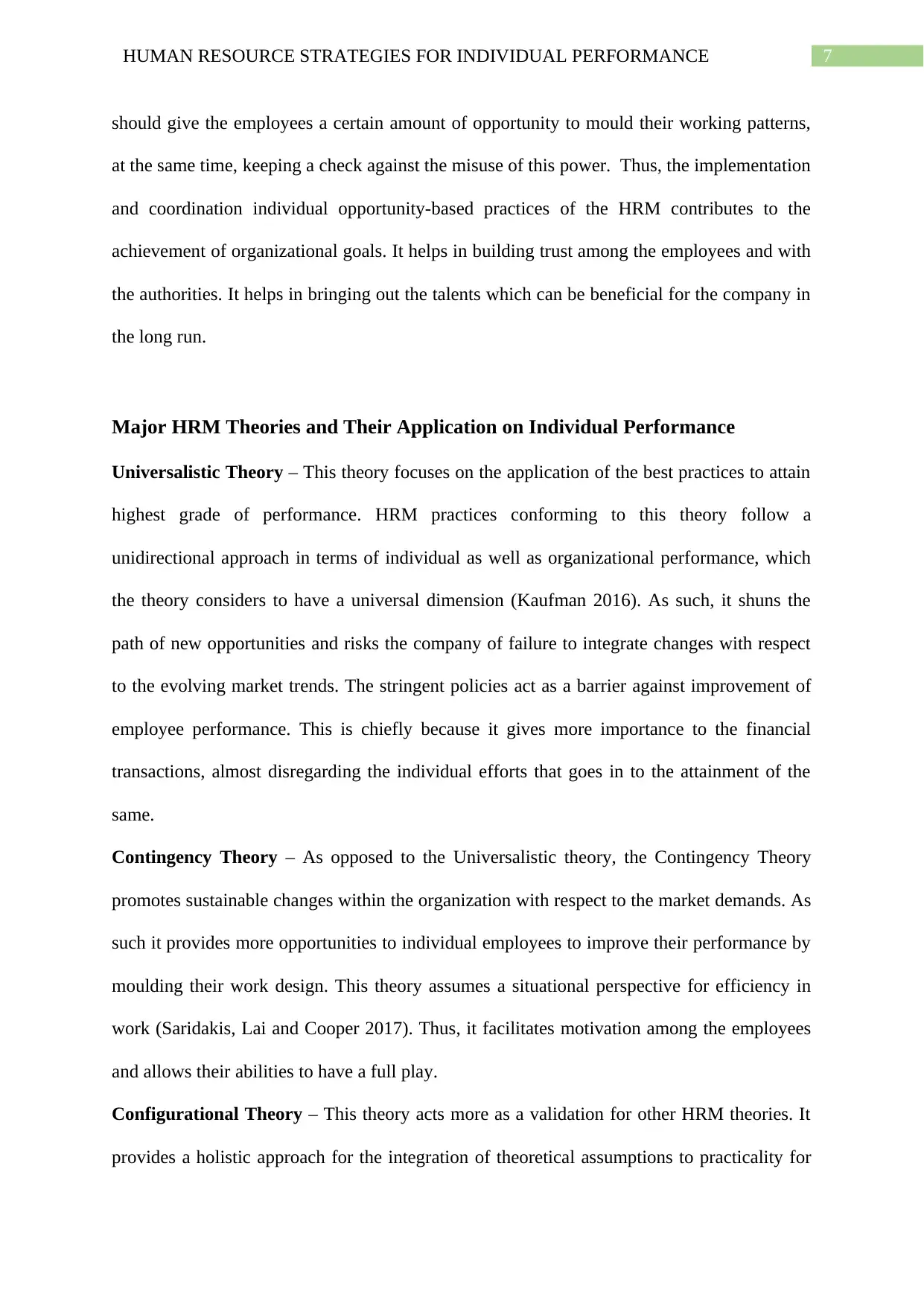
7HUMAN RESOURCE STRATEGIES FOR INDIVIDUAL PERFORMANCE
should give the employees a certain amount of opportunity to mould their working patterns,
at the same time, keeping a check against the misuse of this power. Thus, the implementation
and coordination individual opportunity-based practices of the HRM contributes to the
achievement of organizational goals. It helps in building trust among the employees and with
the authorities. It helps in bringing out the talents which can be beneficial for the company in
the long run.
Major HRM Theories and Their Application on Individual Performance
Universalistic Theory – This theory focuses on the application of the best practices to attain
highest grade of performance. HRM practices conforming to this theory follow a
unidirectional approach in terms of individual as well as organizational performance, which
the theory considers to have a universal dimension (Kaufman 2016). As such, it shuns the
path of new opportunities and risks the company of failure to integrate changes with respect
to the evolving market trends. The stringent policies act as a barrier against improvement of
employee performance. This is chiefly because it gives more importance to the financial
transactions, almost disregarding the individual efforts that goes in to the attainment of the
same.
Contingency Theory – As opposed to the Universalistic theory, the Contingency Theory
promotes sustainable changes within the organization with respect to the market demands. As
such it provides more opportunities to individual employees to improve their performance by
moulding their work design. This theory assumes a situational perspective for efficiency in
work (Saridakis, Lai and Cooper 2017). Thus, it facilitates motivation among the employees
and allows their abilities to have a full play.
Configurational Theory – This theory acts more as a validation for other HRM theories. It
provides a holistic approach for the integration of theoretical assumptions to practicality for
should give the employees a certain amount of opportunity to mould their working patterns,
at the same time, keeping a check against the misuse of this power. Thus, the implementation
and coordination individual opportunity-based practices of the HRM contributes to the
achievement of organizational goals. It helps in building trust among the employees and with
the authorities. It helps in bringing out the talents which can be beneficial for the company in
the long run.
Major HRM Theories and Their Application on Individual Performance
Universalistic Theory – This theory focuses on the application of the best practices to attain
highest grade of performance. HRM practices conforming to this theory follow a
unidirectional approach in terms of individual as well as organizational performance, which
the theory considers to have a universal dimension (Kaufman 2016). As such, it shuns the
path of new opportunities and risks the company of failure to integrate changes with respect
to the evolving market trends. The stringent policies act as a barrier against improvement of
employee performance. This is chiefly because it gives more importance to the financial
transactions, almost disregarding the individual efforts that goes in to the attainment of the
same.
Contingency Theory – As opposed to the Universalistic theory, the Contingency Theory
promotes sustainable changes within the organization with respect to the market demands. As
such it provides more opportunities to individual employees to improve their performance by
moulding their work design. This theory assumes a situational perspective for efficiency in
work (Saridakis, Lai and Cooper 2017). Thus, it facilitates motivation among the employees
and allows their abilities to have a full play.
Configurational Theory – This theory acts more as a validation for other HRM theories. It
provides a holistic approach for the integration of theoretical assumptions to practicality for
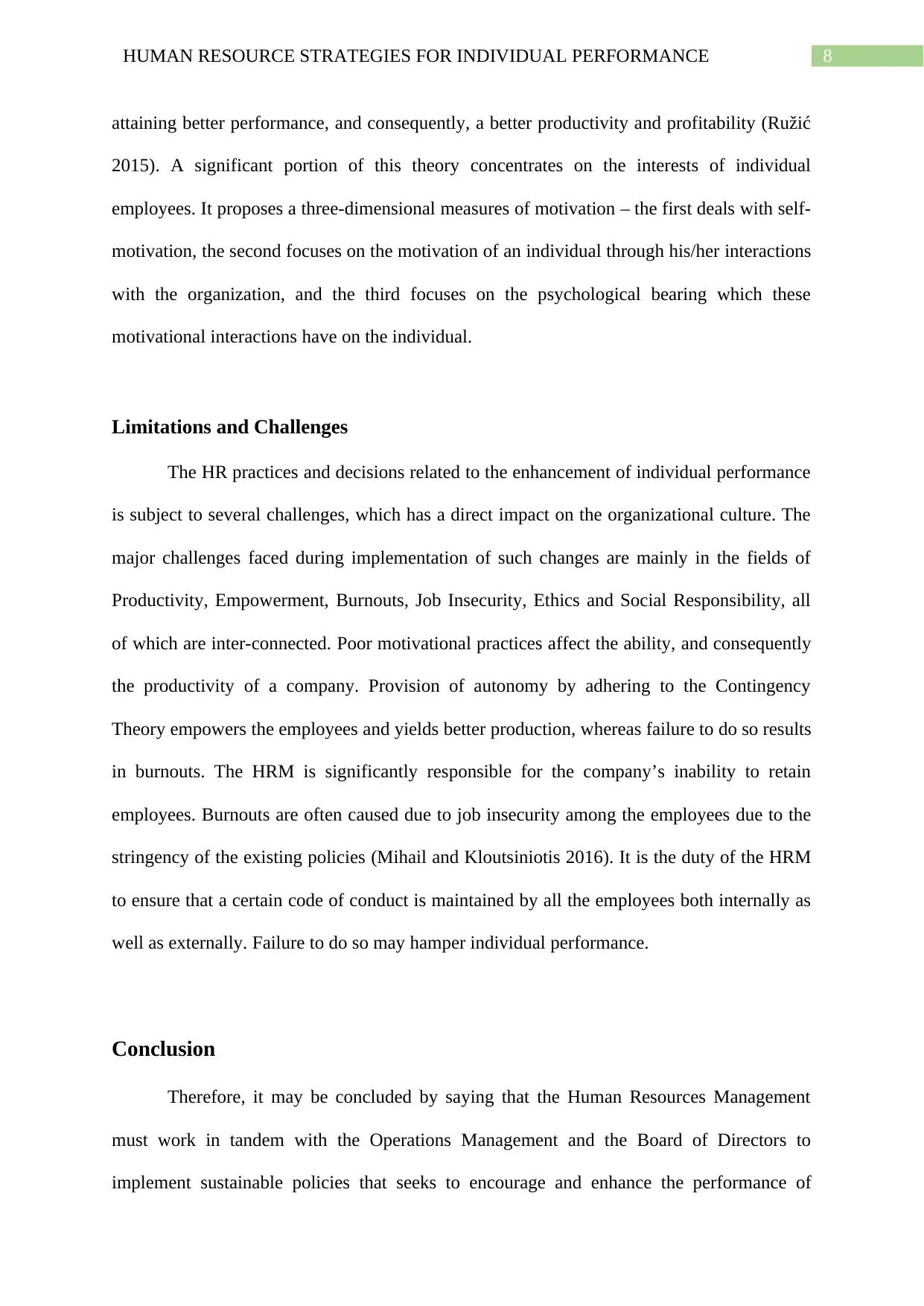
8HUMAN RESOURCE STRATEGIES FOR INDIVIDUAL PERFORMANCE
attaining better performance, and consequently, a better productivity and profitability (Ružić
2015). A significant portion of this theory concentrates on the interests of individual
employees. It proposes a three-dimensional measures of motivation – the first deals with self-
motivation, the second focuses on the motivation of an individual through his/her interactions
with the organization, and the third focuses on the psychological bearing which these
motivational interactions have on the individual.
Limitations and Challenges
The HR practices and decisions related to the enhancement of individual performance
is subject to several challenges, which has a direct impact on the organizational culture. The
major challenges faced during implementation of such changes are mainly in the fields of
Productivity, Empowerment, Burnouts, Job Insecurity, Ethics and Social Responsibility, all
of which are inter-connected. Poor motivational practices affect the ability, and consequently
the productivity of a company. Provision of autonomy by adhering to the Contingency
Theory empowers the employees and yields better production, whereas failure to do so results
in burnouts. The HRM is significantly responsible for the company’s inability to retain
employees. Burnouts are often caused due to job insecurity among the employees due to the
stringency of the existing policies (Mihail and Kloutsiniotis 2016). It is the duty of the HRM
to ensure that a certain code of conduct is maintained by all the employees both internally as
well as externally. Failure to do so may hamper individual performance.
Conclusion
Therefore, it may be concluded by saying that the Human Resources Management
must work in tandem with the Operations Management and the Board of Directors to
implement sustainable policies that seeks to encourage and enhance the performance of
attaining better performance, and consequently, a better productivity and profitability (Ružić
2015). A significant portion of this theory concentrates on the interests of individual
employees. It proposes a three-dimensional measures of motivation – the first deals with self-
motivation, the second focuses on the motivation of an individual through his/her interactions
with the organization, and the third focuses on the psychological bearing which these
motivational interactions have on the individual.
Limitations and Challenges
The HR practices and decisions related to the enhancement of individual performance
is subject to several challenges, which has a direct impact on the organizational culture. The
major challenges faced during implementation of such changes are mainly in the fields of
Productivity, Empowerment, Burnouts, Job Insecurity, Ethics and Social Responsibility, all
of which are inter-connected. Poor motivational practices affect the ability, and consequently
the productivity of a company. Provision of autonomy by adhering to the Contingency
Theory empowers the employees and yields better production, whereas failure to do so results
in burnouts. The HRM is significantly responsible for the company’s inability to retain
employees. Burnouts are often caused due to job insecurity among the employees due to the
stringency of the existing policies (Mihail and Kloutsiniotis 2016). It is the duty of the HRM
to ensure that a certain code of conduct is maintained by all the employees both internally as
well as externally. Failure to do so may hamper individual performance.
Conclusion
Therefore, it may be concluded by saying that the Human Resources Management
must work in tandem with the Operations Management and the Board of Directors to
implement sustainable policies that seeks to encourage and enhance the performance of
⊘ This is a preview!⊘
Do you want full access?
Subscribe today to unlock all pages.

Trusted by 1+ million students worldwide
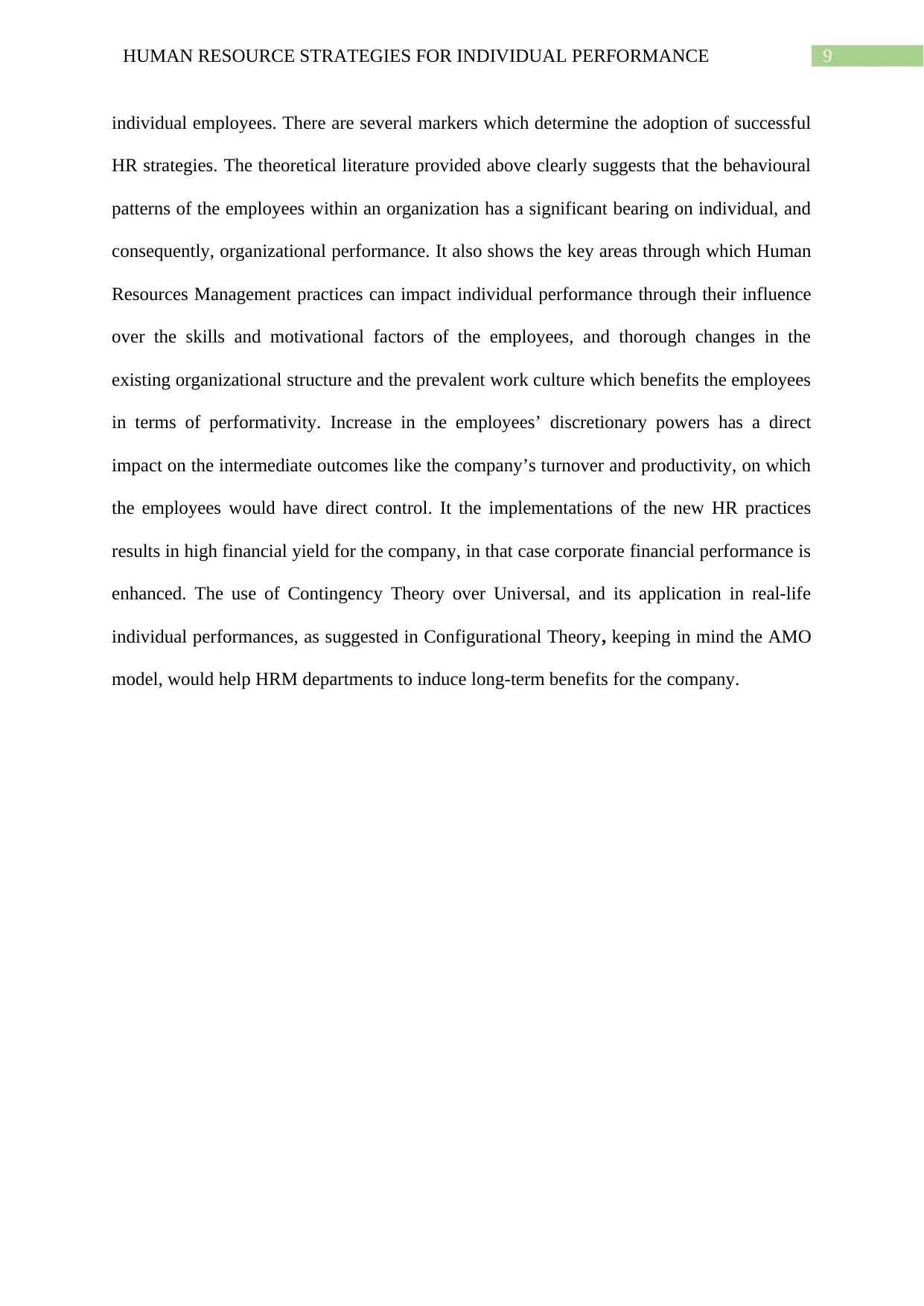
9HUMAN RESOURCE STRATEGIES FOR INDIVIDUAL PERFORMANCE
individual employees. There are several markers which determine the adoption of successful
HR strategies. The theoretical literature provided above clearly suggests that the behavioural
patterns of the employees within an organization has a significant bearing on individual, and
consequently, organizational performance. It also shows the key areas through which Human
Resources Management practices can impact individual performance through their influence
over the skills and motivational factors of the employees, and thorough changes in the
existing organizational structure and the prevalent work culture which benefits the employees
in terms of performativity. Increase in the employees’ discretionary powers has a direct
impact on the intermediate outcomes like the company’s turnover and productivity, on which
the employees would have direct control. It the implementations of the new HR practices
results in high financial yield for the company, in that case corporate financial performance is
enhanced. The use of Contingency Theory over Universal, and its application in real-life
individual performances, as suggested in Configurational Theory, keeping in mind the AMO
model, would help HRM departments to induce long-term benefits for the company.
individual employees. There are several markers which determine the adoption of successful
HR strategies. The theoretical literature provided above clearly suggests that the behavioural
patterns of the employees within an organization has a significant bearing on individual, and
consequently, organizational performance. It also shows the key areas through which Human
Resources Management practices can impact individual performance through their influence
over the skills and motivational factors of the employees, and thorough changes in the
existing organizational structure and the prevalent work culture which benefits the employees
in terms of performativity. Increase in the employees’ discretionary powers has a direct
impact on the intermediate outcomes like the company’s turnover and productivity, on which
the employees would have direct control. It the implementations of the new HR practices
results in high financial yield for the company, in that case corporate financial performance is
enhanced. The use of Contingency Theory over Universal, and its application in real-life
individual performances, as suggested in Configurational Theory, keeping in mind the AMO
model, would help HRM departments to induce long-term benefits for the company.
Paraphrase This Document
Need a fresh take? Get an instant paraphrase of this document with our AI Paraphraser
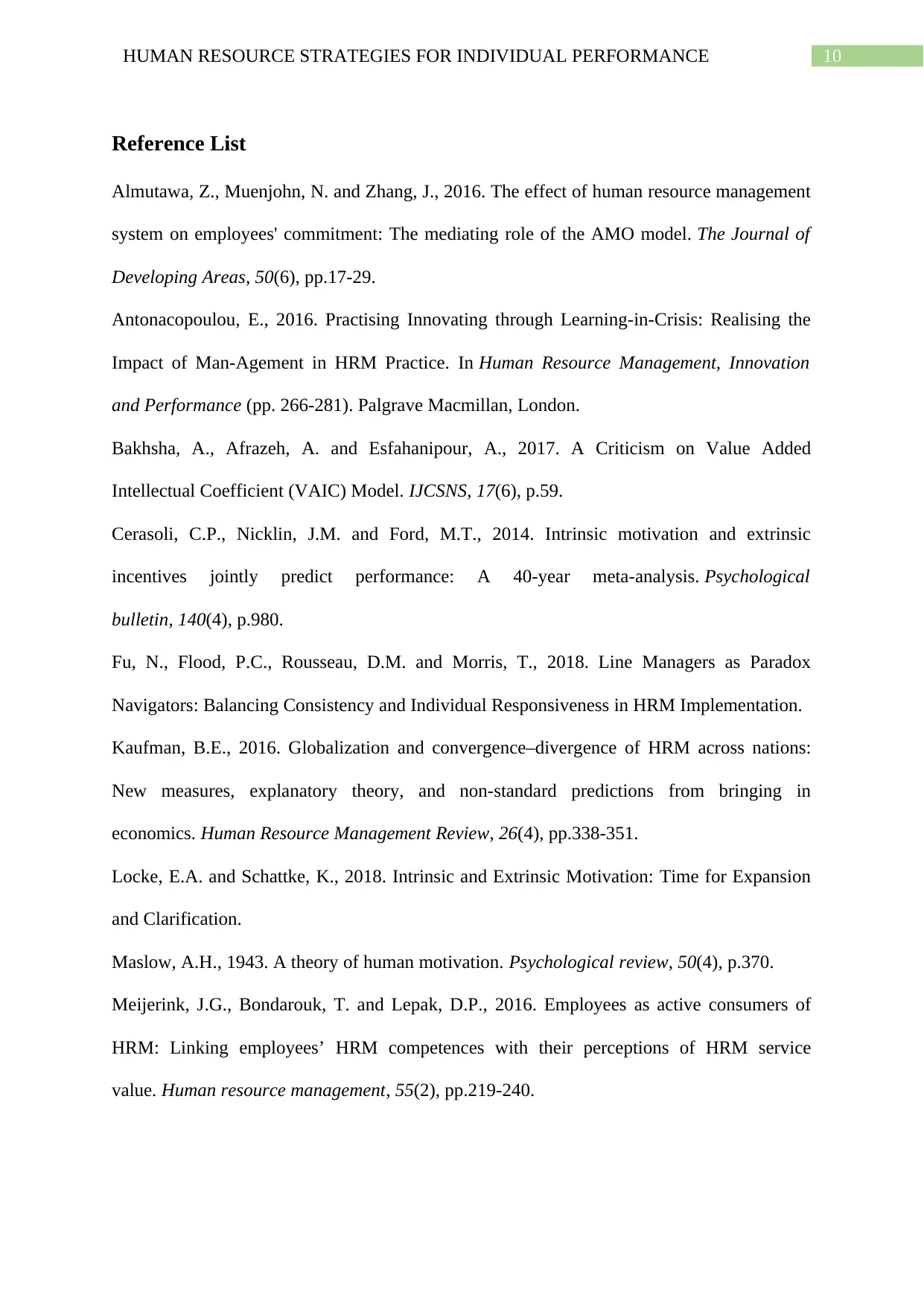
10HUMAN RESOURCE STRATEGIES FOR INDIVIDUAL PERFORMANCE
Reference List
Almutawa, Z., Muenjohn, N. and Zhang, J., 2016. The effect of human resource management
system on employees' commitment: The mediating role of the AMO model. The Journal of
Developing Areas, 50(6), pp.17-29.
Antonacopoulou, E., 2016. Practising Innovating through Learning-in-Crisis: Realising the
Impact of Man-Agement in HRM Practice. In Human Resource Management, Innovation
and Performance (pp. 266-281). Palgrave Macmillan, London.
Bakhsha, A., Afrazeh, A. and Esfahanipour, A., 2017. A Criticism on Value Added
Intellectual Coefficient (VAIC) Model. IJCSNS, 17(6), p.59.
Cerasoli, C.P., Nicklin, J.M. and Ford, M.T., 2014. Intrinsic motivation and extrinsic
incentives jointly predict performance: A 40-year meta-analysis. Psychological
bulletin, 140(4), p.980.
Fu, N., Flood, P.C., Rousseau, D.M. and Morris, T., 2018. Line Managers as Paradox
Navigators: Balancing Consistency and Individual Responsiveness in HRM Implementation.
Kaufman, B.E., 2016. Globalization and convergence–divergence of HRM across nations:
New measures, explanatory theory, and non-standard predictions from bringing in
economics. Human Resource Management Review, 26(4), pp.338-351.
Locke, E.A. and Schattke, K., 2018. Intrinsic and Extrinsic Motivation: Time for Expansion
and Clarification.
Maslow, A.H., 1943. A theory of human motivation. Psychological review, 50(4), p.370.
Meijerink, J.G., Bondarouk, T. and Lepak, D.P., 2016. Employees as active consumers of
HRM: Linking employees’ HRM competences with their perceptions of HRM service
value. Human resource management, 55(2), pp.219-240.
Reference List
Almutawa, Z., Muenjohn, N. and Zhang, J., 2016. The effect of human resource management
system on employees' commitment: The mediating role of the AMO model. The Journal of
Developing Areas, 50(6), pp.17-29.
Antonacopoulou, E., 2016. Practising Innovating through Learning-in-Crisis: Realising the
Impact of Man-Agement in HRM Practice. In Human Resource Management, Innovation
and Performance (pp. 266-281). Palgrave Macmillan, London.
Bakhsha, A., Afrazeh, A. and Esfahanipour, A., 2017. A Criticism on Value Added
Intellectual Coefficient (VAIC) Model. IJCSNS, 17(6), p.59.
Cerasoli, C.P., Nicklin, J.M. and Ford, M.T., 2014. Intrinsic motivation and extrinsic
incentives jointly predict performance: A 40-year meta-analysis. Psychological
bulletin, 140(4), p.980.
Fu, N., Flood, P.C., Rousseau, D.M. and Morris, T., 2018. Line Managers as Paradox
Navigators: Balancing Consistency and Individual Responsiveness in HRM Implementation.
Kaufman, B.E., 2016. Globalization and convergence–divergence of HRM across nations:
New measures, explanatory theory, and non-standard predictions from bringing in
economics. Human Resource Management Review, 26(4), pp.338-351.
Locke, E.A. and Schattke, K., 2018. Intrinsic and Extrinsic Motivation: Time for Expansion
and Clarification.
Maslow, A.H., 1943. A theory of human motivation. Psychological review, 50(4), p.370.
Meijerink, J.G., Bondarouk, T. and Lepak, D.P., 2016. Employees as active consumers of
HRM: Linking employees’ HRM competences with their perceptions of HRM service
value. Human resource management, 55(2), pp.219-240.
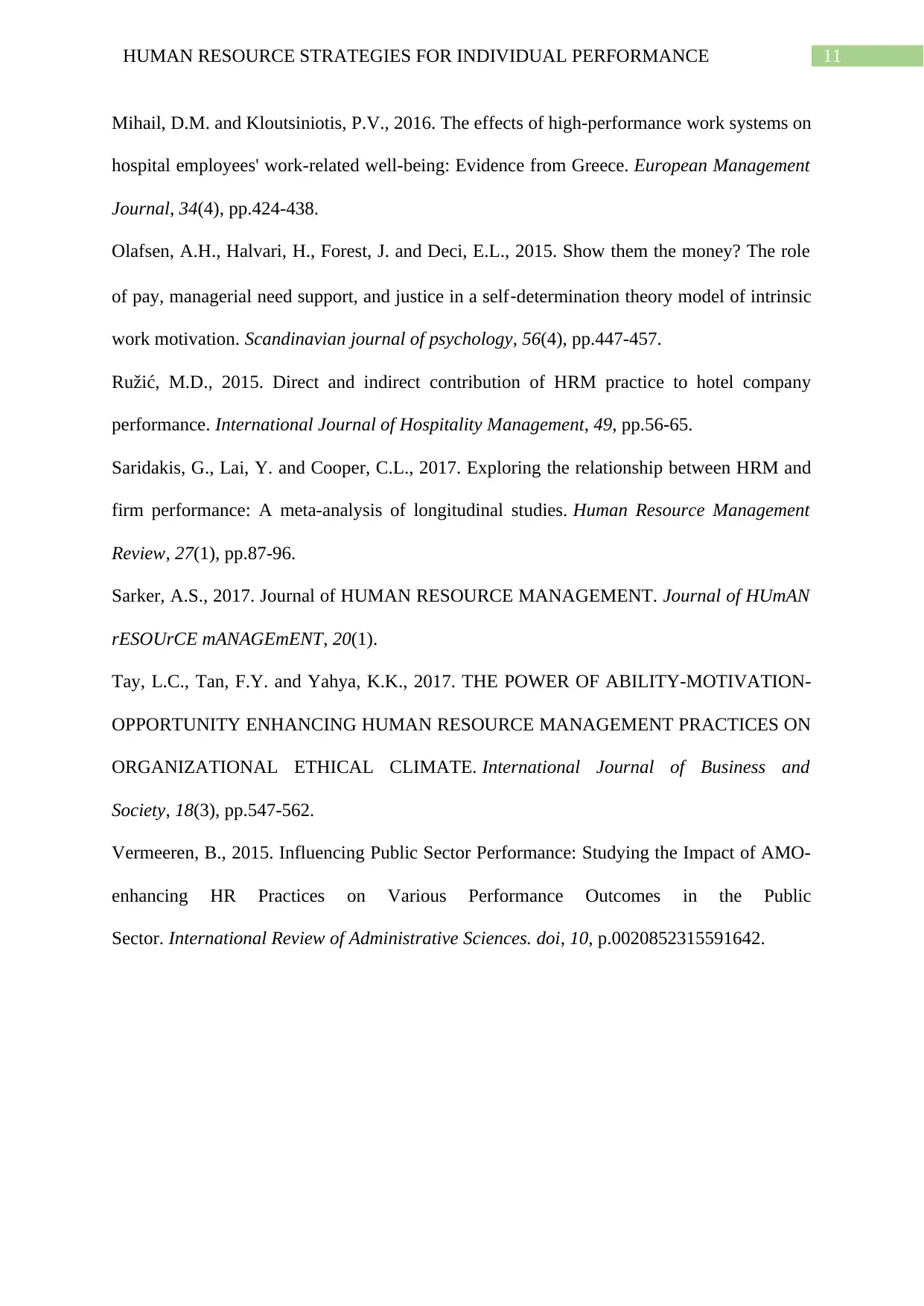
11HUMAN RESOURCE STRATEGIES FOR INDIVIDUAL PERFORMANCE
Mihail, D.M. and Kloutsiniotis, P.V., 2016. The effects of high-performance work systems on
hospital employees' work-related well-being: Evidence from Greece. European Management
Journal, 34(4), pp.424-438.
Olafsen, A.H., Halvari, H., Forest, J. and Deci, E.L., 2015. Show them the money? The role
of pay, managerial need support, and justice in a self‐determination theory model of intrinsic
work motivation. Scandinavian journal of psychology, 56(4), pp.447-457.
Ružić, M.D., 2015. Direct and indirect contribution of HRM practice to hotel company
performance. International Journal of Hospitality Management, 49, pp.56-65.
Saridakis, G., Lai, Y. and Cooper, C.L., 2017. Exploring the relationship between HRM and
firm performance: A meta-analysis of longitudinal studies. Human Resource Management
Review, 27(1), pp.87-96.
Sarker, A.S., 2017. Journal of HUMAN RESOURCE MANAGEMENT. Journal of HUmAN
rESOUrCE mANAGEmENT, 20(1).
Tay, L.C., Tan, F.Y. and Yahya, K.K., 2017. THE POWER OF ABILITY-MOTIVATION-
OPPORTUNITY ENHANCING HUMAN RESOURCE MANAGEMENT PRACTICES ON
ORGANIZATIONAL ETHICAL CLIMATE. International Journal of Business and
Society, 18(3), pp.547-562.
Vermeeren, B., 2015. Influencing Public Sector Performance: Studying the Impact of AMO-
enhancing HR Practices on Various Performance Outcomes in the Public
Sector. International Review of Administrative Sciences. doi, 10, p.0020852315591642.
Mihail, D.M. and Kloutsiniotis, P.V., 2016. The effects of high-performance work systems on
hospital employees' work-related well-being: Evidence from Greece. European Management
Journal, 34(4), pp.424-438.
Olafsen, A.H., Halvari, H., Forest, J. and Deci, E.L., 2015. Show them the money? The role
of pay, managerial need support, and justice in a self‐determination theory model of intrinsic
work motivation. Scandinavian journal of psychology, 56(4), pp.447-457.
Ružić, M.D., 2015. Direct and indirect contribution of HRM practice to hotel company
performance. International Journal of Hospitality Management, 49, pp.56-65.
Saridakis, G., Lai, Y. and Cooper, C.L., 2017. Exploring the relationship between HRM and
firm performance: A meta-analysis of longitudinal studies. Human Resource Management
Review, 27(1), pp.87-96.
Sarker, A.S., 2017. Journal of HUMAN RESOURCE MANAGEMENT. Journal of HUmAN
rESOUrCE mANAGEmENT, 20(1).
Tay, L.C., Tan, F.Y. and Yahya, K.K., 2017. THE POWER OF ABILITY-MOTIVATION-
OPPORTUNITY ENHANCING HUMAN RESOURCE MANAGEMENT PRACTICES ON
ORGANIZATIONAL ETHICAL CLIMATE. International Journal of Business and
Society, 18(3), pp.547-562.
Vermeeren, B., 2015. Influencing Public Sector Performance: Studying the Impact of AMO-
enhancing HR Practices on Various Performance Outcomes in the Public
Sector. International Review of Administrative Sciences. doi, 10, p.0020852315591642.
⊘ This is a preview!⊘
Do you want full access?
Subscribe today to unlock all pages.

Trusted by 1+ million students worldwide
1 out of 13
Related Documents
Your All-in-One AI-Powered Toolkit for Academic Success.
+13062052269
info@desklib.com
Available 24*7 on WhatsApp / Email
![[object Object]](/_next/static/media/star-bottom.7253800d.svg)
Unlock your academic potential
Copyright © 2020–2025 A2Z Services. All Rights Reserved. Developed and managed by ZUCOL.




